This Harvest Pork Stew will be your go-to when chilly weather strikes. Heck, even here in “balmy” San Antonio, this hearty dinner is a favorite. Meaty pork shoulder simmers in a Guinness and beef broth laden with sweet potatoes and chunks of butternut squash. Fresh herbs like sage, rosemary, and thyme add even more comfort to an already cozy dish. This one-pot meal is a simple way to feed a crowd, but it easily converts to a freezer meal if you have a smaller appetite or crew.
I’ll be the first to admit, the only thing I’ve “harvested” in my life are some carrots we accidentally sowed in the backyard in El Paso. Long story short, we failed at a raised garden bed, and in his frustration, Hector tossed the soil onto the back lawn. He went to South Korea for a year and, since we were living in military housing, maintenance workers were sent to cut the grass. Next thing you know, two guys are outside damn near dying of laughter on the back lawn. They’d plucked carrots from the yard. Turns out we weren’t that bad at gardening. I ducked down to hide in shame, then went out after they left to get the rest of my doggone carrots.
*I originally published this recipe in November 2017. I’ve since made updates to the images, copy, and recipe instructions.*
What is a Harvest Stew?
Back in the day, I may or may not have been a great pioneer or farmer. I know that today, we are pretty far removed from the sources of what we eat. The harvest was a time for neighbors to join together and reap the bounty of all their hard work throughout the growing season. Now, at least in my country, it’s more like, “Let’s go to the store and complain about not having organic toilet paper.” The harvest is a time to take stock of what nature has given you and your family.
Our daughter loves this recipe. She loves it so much she scared the bejeezus out of me the night I made it. We went out for date night and received a text from her that read, “crying my eyes out.” I freaked out thinking some maniac broke into the house and was in the process of killing her and her twin. Never mind that she wouldn’t be able to text if she was being killed. Turns out, she loved the stew so much, she claimed it brought tears to her eyes. I said thanks, then grounded her for a week.
What’s the “harvest” part of it, then?
No, I didn’t pluck these ingredients from the soil on my acres of farmland. So what about the recipe makes it a “harvest stew”? Well, just because you or I didn’t grow or pick it doesn’t mean we can’t call it a harvest.
In Texas, and in most parts of the country, carrots, celery, potatoes, sweet potatoes, and squash are all in season. These ingredients, along with onions, garlic, fresh herbs, spices, beef broth, Guinness, and pork, all go into this stew. So, while we may not be farmers, we’re honoring the farmers and meat producers who made this recipe possible.
If you don’t have a big stockpot or dutch oven, this is a good time to pick one up. This is a 10-quart or larger affair here.
What cut of pork do I use in this stew?
You want a cut of pork that isn’t too lean for this recipe, so tenderloin is out. Because we add thick, fibrous veggies, they need time to soften. A lean cut of pork will dry out, yes, even in a stew, and become too tough. Instead, a fattier cut is better. To avoid extra work, I use boneless country ribs, which is a confusing cut. They’re not cut from the ribs of the pig at all. They’re actually the pork shoulder. Like ribs, though, they are meaty and, when cooked properly, are super-tender.
Country ribs also have a good amount of fat and marbling throughout the meat. That means we can simmer them for the time it takes to soften our root veggies without drying them out. You can find them labeled as pork loin country-style ribs in the pork section of your grocery store. Other names are country ribs, boneless pork shoulder, or boneless Boston butt. All of these cuts come from the same area of the pig. All require a small amount of effort on your part, as well, since you need to cut them into chunks.
Try to select meat that doesn’t have too much skin and fat on it. The skin will turn rubbery, and the fat will make the stew greasy. My ribs are toeing the line between just right and too fatty. I have two weirdos who love gristle and fat, so that’s the only reason I leave it on. You can trim most of the fat and skin away, however. This cut of meat is fatty enough on its own.
Can I replace the pork in this harvest stew with a different type of meat?
If you’re not a pork-eater, you can most certainly replace the pork in this recipe with another red meat. Beef chuck, round, or point brisket are the best beef cuts to use in this stew. If you’re a fan of lamb, you can replace the pork in this recipe with chunks of lamb shoulder or leg of lamb.
Bison, goat, veal, or venison chunks are other options for replacing the pork in this stew.
Avoid leaner cuts of these meats and lean meats in general, though. Rabbit, chicken, and turkey are a bit too lean for the longer simmering time this stew will go through.
How do I season the pork?
In a small mixing bowl, combine the kosher salt, black pepper, and granulated garlic powder to make a seasoning blend.
Cut the meat into 1-inch chunks. Then, sprinkle the entire amount of spice blend over the meat. I know this seems like a lot to use, but we won’t need to adjust the seasonings at any point after this. This is what they call in the Army, “One shot, one kill.” You’re knocking out all of the seasoning for the stew in one fell swoop.
Can I season the pork ahead for this harvest stew?
If you want to get a headstart on prep for this stew, you can most certainly season the meat up to six months ahead. After you season it, toss it into a freezer storage bag and freeze it for that long. You can thaw it in the fridge the night before you plan to make the stew.
You can also just season it a day ahead and store it in a covered container in the fridge.
Once you’re set to make the stew, you need to coat it in a small amount of all-purpose flour. You don’t want to do this before freezing because the flour will cake onto the meat upon thawing. Next, toss the seasoned pork in the flour. You only want a light coating of flour on the meat. This helps to give color to the “other white meat” and thicken the stew later. The flour is optional, though, so if you’re on a gluten-free diet, you can omit it. Your stew won’t be as thick as mine is, but the potatoes and squash will still thicken it up sufficiently.
How do I properly sear the pork?
One thing I notice when people sear meat is that they’re afraid to go too high or too dark. The point of searing meat is to get a Maillard reaction going. This chemical reaction between the sugar and amino acids in the pork can be seen in the browning of the meat. That browning or caramelization translates to flavor in your food. For the reaction to occur, however, you need to hit the meat’s exterior with high heat. The goal is not to cook the pork all the way through here. You only want to give the outside of the meat some brown color.
Heat a high-heat- vegetable or peanut- oil in your large stockpot over medium-high heat. Turn on the exhaust fan because the meat may create a small amount of smoke towards the end of searing. Once you see the oil in the pot going wavy, add a handful of the seasoned meat to the pot. Try not to crowd the pot, or the meat won’t caramelize properly. Take a look at the amount of meat in the image. You want your meat to have space around it.
Sear the meat for 3 minutes, turning it to sear each side well. Use a slotted spoon to remove the meat from the pot to a bowl or dish, then add the next batch of meat. Continue searing the meat in batches like this until they’re all browned, and you have a nice amount of browned bits on the bottom of your pot.
There’s a bunch of burnt stuff on my pot!
Uh, excuse you!! That’s not “burnt stuff.” That’s fond AKA browned bits AKA flavor. That’s, along with the Maillard reaction, along with the spices and stock, are what make this harvest stew so bangin’.
If you don’t see any glossy oil on the bottom of your pot, add another tablespoon to it. Next, add the mirepoix- the celery, carrots, and onions- and garlic to the pot. Stir the veggies with a wooden spoon. Sauté the veggies over medium-high heat for 3-4 minutes, or until they are glossy and just starting to take on a golden brown color.
Pour the Guinness into the pot. Be careful because it will steam quite a bit. Once all of the beer is in the pot, use your spoon to scrape that fond from the bottom of the pot. The heat from the pot and the liquid and acidity of the beer will help the browned bits release from the bottom.
I don’t drink alcohol. What can I replace the Guinness with?
If you’re not a drinker, you can replace the Guinness in this recipe with more beef stock. Just use the same amount.
If you’re not a fan of Guinness, you can use any lager, stout, or ale you do like. I’ve even made this with a pumpkin stout, and that stew tasted killer.
Once the fond has been scraped from the bottom of the pot, return the seared pork to the pot. Bring the mixture up to a gentle boil.
What other kind of veggies can I use here?
Tis the season for winter squashes and sweet potatoes!
Butternut squash is an excellent source of vitamin C, which is great because we’re also entering flu season. I’m adding chunks of butternut squash, sweet potato, boniato (white sweet potato), and Russet potato to the pot.
Some other options for this recipe are:
- acorn squash, kabocha squash, or delicata squash
- pumpkin
- purple yam or ube
- parsnips
- rutabaga
The key to getting the right balance of flavor is to combine mildly sweet with unsweet. So, don’t fill your stockpot with a bunch of sweet root veggies, like sweet potato, boniato, and pie pumpkins. Give the stew some balance by choosing unsweet potatoes, sweet potatoes, and a middle-of-the-road squash.
Decide which root veggies or squash you want to use and cut them into 1-inch cubes. Add the veggies to the pot along with the bay leaves. Bring this mixture back up to a boil, frequently stirring to keep anything from sticking to the bottom of the pot.
When do I add the herbs to my stew?
The answer to this question depends on whether you’re using dried or fresh herbs. Dried herbs need a longer cook time to release maximum flavor. That’s because they need to be rehydrated. On the other hand, fresh herbs should be added at the last minute, just before serving, to give you their best flavor.
If you are using dried herbs, add them towards the last 10 minutes of cooking time. Fresh herbs can be stirred in just before serving or right before you turn off the stove.
I use a combination of herbs that pair well with pork: sage, rosemary, and thyme. You can use all or just one or two of these. Avoid super bright-tasting herbs like cilantro or parsley. These tend to compete too much with the warm, earthy flavors of the stew.
How long does the stew need to cook?
Once the stew comes back up to a boil, turn the heat to low and cover the pot. Allow the stew to simmer for 35-45 minutes, or until the potatoes are fork-tender. Don’t forget to add the dried herbs 10 minutes before the end of cooking!
Turn the stove off, and stir in any fresh herbs if that’s the route you’re taking.
How do I serve the Harvest Stew?
I always serve this stew with some type of bread. Since it’s a complete meal-in-a-pot with veggies, proteins, and starches, you truly don’t need anything else. But, I mean, what sane person would turn down a warm piece of bread with a big bowl of soup?
Here are the ones I usually turn to:
How long can I store leftover Harvest Stew?
Once you’ve had your fill, transfer room temperature leftovers to a food storage container.
Store the leftovers in the fridge for up to 3 days. Reheat only the amount you plan to eat in the microwave or on the stove in a pot until warmed through.
Can I freeze leftover stew?
Yes, you can. I actually freeze this harvest stew in individual portion sizes in case we have a busy week coming up. That way, I’m not committed to consuming an entire batch of stew before it goes bad. Just portion out the stew into small 10- or 12-ounce freezer containers. That way, whoever in the family needs a quick meal can grab it, defrost it, and have their own dinner ready to go.
To freeze a large batch of leftover stew:
- Allow it to cool completely.
- Transfer the stew to a freezer-safe storage container.
- Freeze the stew for up to 3 months.
Thaw the stew in the fridge overnight, then reheat in the microwave or on the stovetop.
Can I make this stew in a slow cooker?
To convert this recipe to a slow cooker stew:
- Sear the pork and sauté the mirepoix as instructed, deglazing the pot with the Guinness, too.
- Add everything to a large-capacity slow cooker and stir it all together.
- Cook the stew on low for 8 hours, stirring in the herbs just before serving.
So, even though we didn’t pick nary a thing in this recipe, we’re still going to celebrate the harvest season by eating it. It is a great reminder to be thankful for the bounty we do have, isn’t it?
Pin this Harvest Pork Stew recipe to your soups and stews board so you can make it later. And don’t forget to share it with your friends and family!
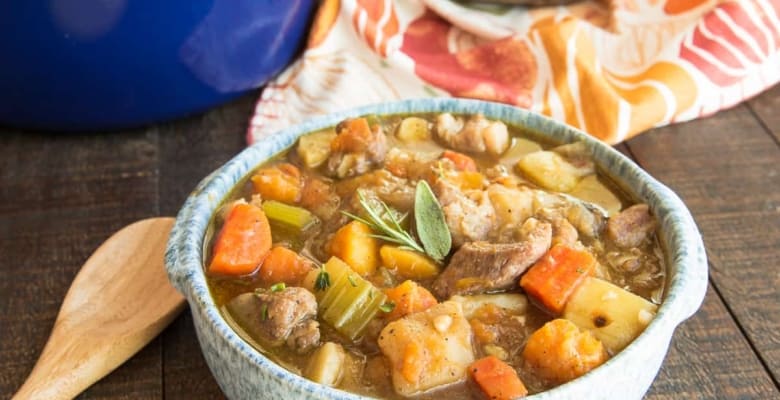
Harvest Pork Stew with Butternut Squash
at Sense & EdibilityEquipment
- 10 or 12-quart stockpot or dutch oven
Ingredients
- 2 tablespoons (17 grams) kosher salt
- 1 1/2 tablespoons (10 grams) granulated garlic
- 1 tablespoon (7 grams) black pepper
- 2 3/4 pounds (1 1/4 kilograms) boneless country style pork ribs cut into 1-1 1/2-inch chunks
- 2 tablespoons (18 grams) all purpose flour
- 1/4 cup (60 milliliters) vegetable oil
- 1 large (2 1/2 cups or 350 grams) white onion peeled and chopped
- 3 stalks (2 cups or 230 grams) celery trimmed and cut 1/2-inch thick
- 3 medium (2 cups or 290 grams) carrots peeled and sliced 1/2-inch thick
- 6 cloves garlic peeled and roughly chopped
- 11.2 ounce bottle (330 milliliters) Guinness Stout or dark lager
- 4 cups (237 milliliters) beef broth
- 1/2 (4 cups or 500 grams) butternut squash peeled and cut into 1" chunks
- 1 large (about 1 1/2 cups or 225 grams) russet potato peeled and cut into 1" chunks
- 1 large (1 1/2 cups or 225 grams) sweet potato peeled and cut into 1" chunks
- 1 medium (1 cup or 200 grams) boniato (white sweet potato), peeled and cut into 1" chunks
- 2 bay leaves
- 3 stems (1 tablespoon) fresh sage minced (or 1 teaspoon dried, rubbed sage)
- 2 stems (about 1 1/2 tablespoons) fresh rosemary leaves removed and chopped (or 1 1/2 teaspoons dried, crushed rosemary)
- 2 stems (about 3/4 tablespoons) fresh thyme stems removed (or 1 teaspoon dried thyme leaves)
Instructions
Season, then Sear the Pork
- In a small mixing bowl, combine the kosher salt, granulated garlic, and black pepper to create a spice blend. Sprinkle all of the spice blend over the meat.
- Toss the seasoned pork lightly in the all-purpose flour. The meat should have a light dusting of flour. Shake off any excess to prevent it from scorching in the oil when you sear the meat.
- Heat the vegetable oil in a 10 or 12-quart stockpot over medium-high heat. When the oil in the pot begins to shimmer, add a handful of the seasoned meat to the pot. Avoid crowding the pot, or the meat won't caramelize properly, leave some space around each piece of meat.
- Sear the meat for 3-4 minutes, turning it to sear each side well. Use a slotted spoon to remove the meat from the pot to a bowl or dish, then add the next batch of meat. Continue searing the meat in batches like this until they're all browned, and browned bits remaining on the bottom of the pot.
Sauté the Aromatics, then Deglaze the Pot with the Beer
- If no oil is visible on bottom of your pot, add another tablespoon to it. Once the oil is hot, add the onion, celery, carrots, and garlic to the pot. Sauté the veggies over medium-high heat, frequently stirring with a wooden spoon, for 3-4 minutes, or until they are glossy and just starting to take on a golden brown color.
- Pour the Guinness into the pot. Be careful because it will steam quite a bit. Once all of the beer has been added to the pot, use the spoon to scrape that browned bits (fond) from the bottom of the pot.
Return the Pork to the Pot, Along with the Veggies, then Simmer
- Once the fond has been scraped from the bottom of the pot, add the beef stock to the pot.Next, return the seared pork to the pot. Bring the liquid in the pot up to a gentle boil.
- After the stock has come to a boil, add the butternut squash, potato, sweet potato, boniato, and bay leaves to the pot. Bring this mixture back up to a boil, frequently stirring to keep anything from sticking to the bottom of the pot.
- Once the stew is boiling, cover the pot and reduce the heat to low.Simmer the stew for 35-45 minutes, or until the potatoes are fork-tender, stirring occasionally.
Add the Herbs at the Right Time, then Serve
- If you are using dried herbs, stir them into the stew towards the last 10 minutes of cooking time. Once the potatoes are tender, remove the stew from the heat and serve.Fresh herbs can be stirred in just before serving or right before you turn off the stove.
- Ladle the stew into soup bowls and serve with warm, crusty bread or on its own.
Notes
Swaps and Substitutions:
- Replace the pork in this recipe with equal weight of chunks or beef (chuck, round, or point brisket), lamb (shoulder or leg), bison, goat, veal, or venison.
- The flour coating on the pork is optional. If you're on a gluten-free diet, you can omit it.
- You can replace the Guinness in this recipe with beef stock.
- If you're not a fan of Guinness, you can use any lager, stout, or ale you do like.
- Use a combination of these root veggies in this recipe: acorn squash, kabocha squash, delicata squash, pumpkin, purple yam or ube, parsnips, and/or rutabaga.
- You can use sage, rosemary, and thyme or just one or two of these. Avoid bright herbs like cilantro and parsley.
Tips and Tricks:
- Make-Ahead:
- Season the pork up to six months ahead, then transfer it to a freezer storage bag. Thaw the meat the fridge the night before you plan to make the stew.
- You can also just season it a day ahead and store it in a covered container in the fridge.
Slow Cooker Method:
- Sear the pork and sauté the mirepoix as instructed, deglazing the pot with the Guinness.
- Add everything to a large-capacity slow cooker and stir it all together.
- Cook the stew on low for 8 hours, stirring in the herbs just before serving.
Storage and Reheating Instructions:
- Storing Leftovers:
- Transfer room temperature leftovers to a food storage container.
- Store the leftovers in the fridge for up to 3 days.
- Reheat only the amount you plan to eat in the microwave or on the stove in a pot until warmed through.
- Freezing Instructions:
- Allow it to cool completely.
- Transfer the stew to a freezer-safe storage container.
- Freeze the stew for up to 3 months.
- Thaw the stew in the fridge overnight, then reheat in the microwave or on the stovetop.

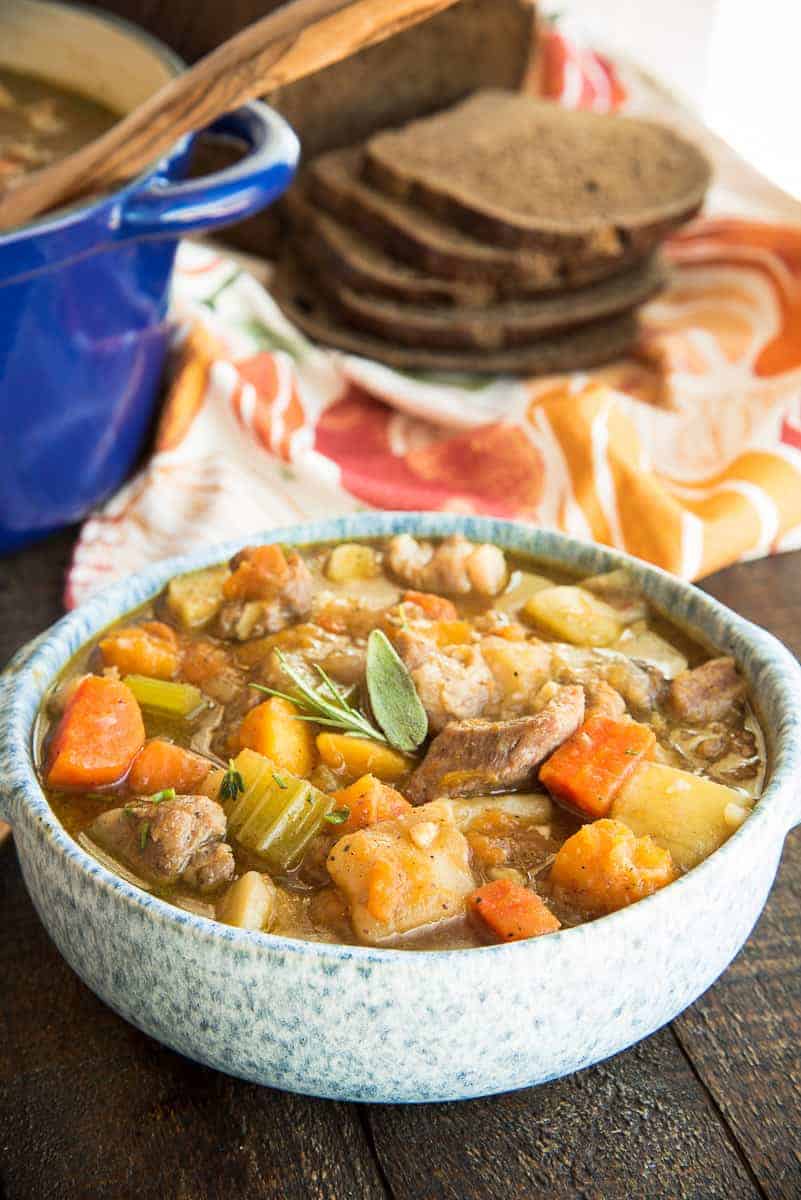
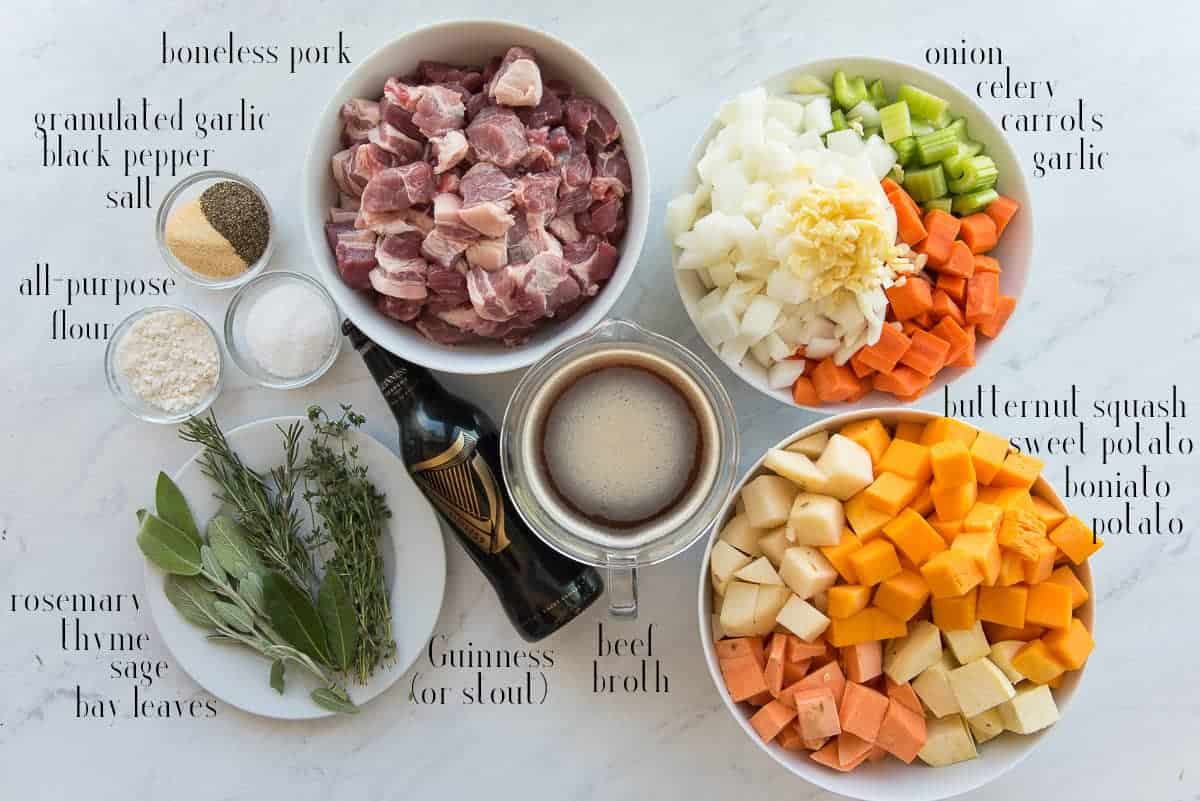
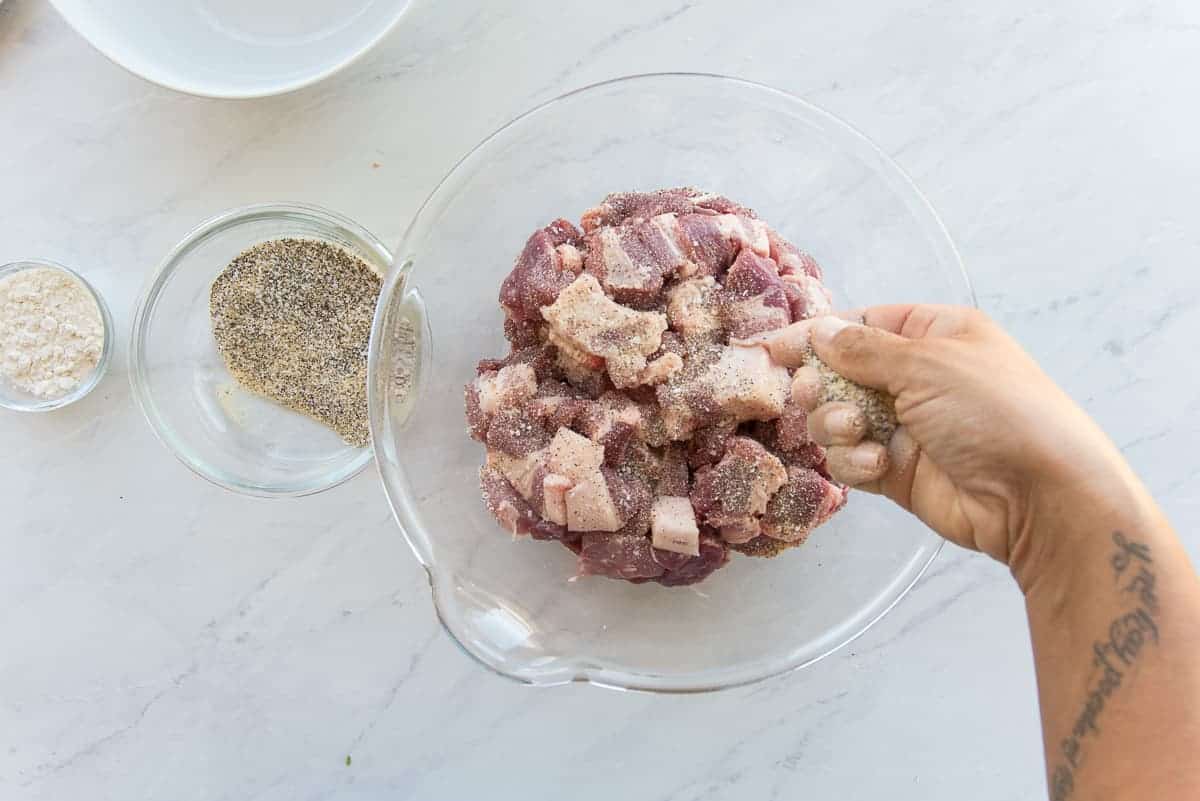
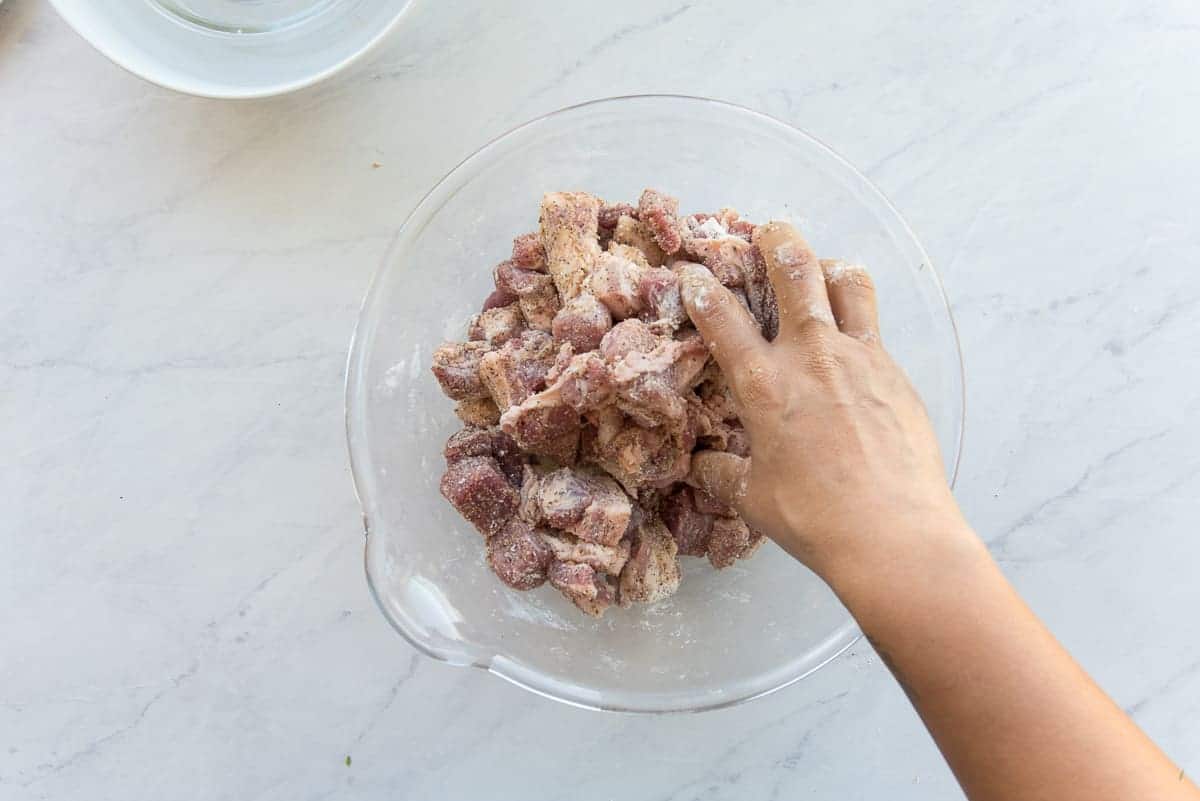

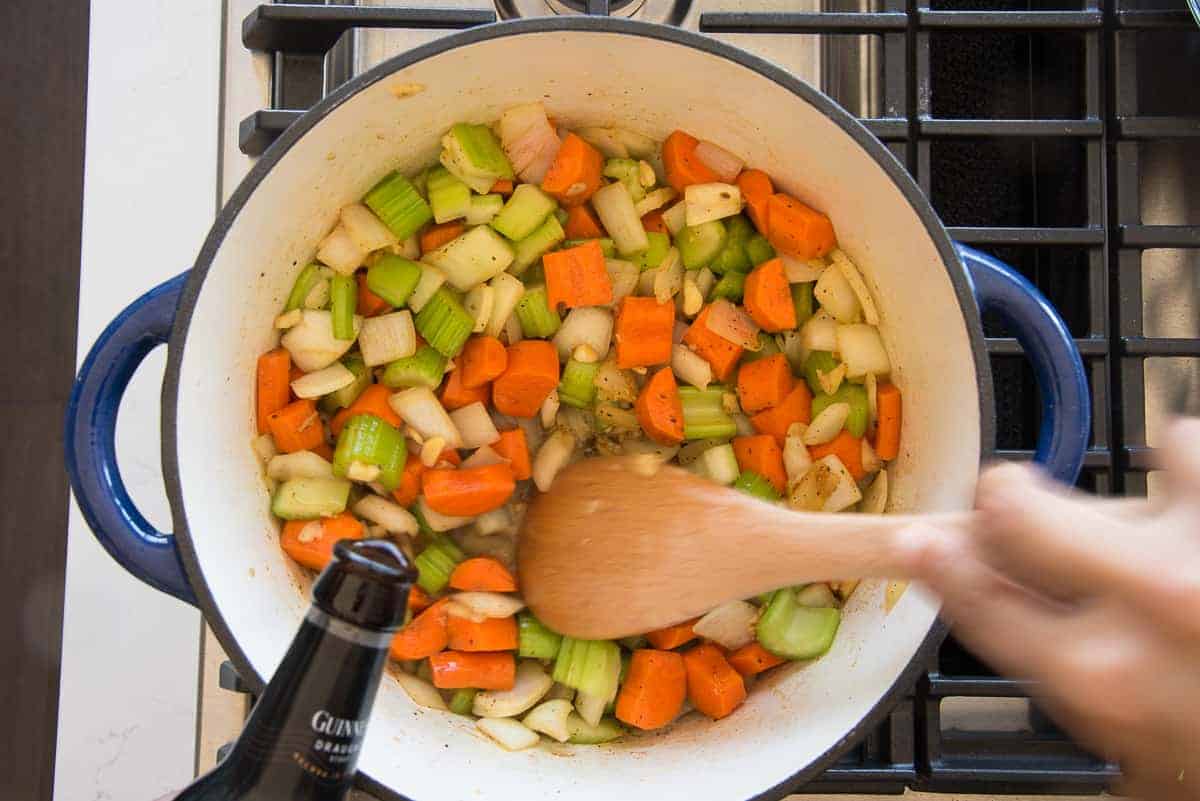
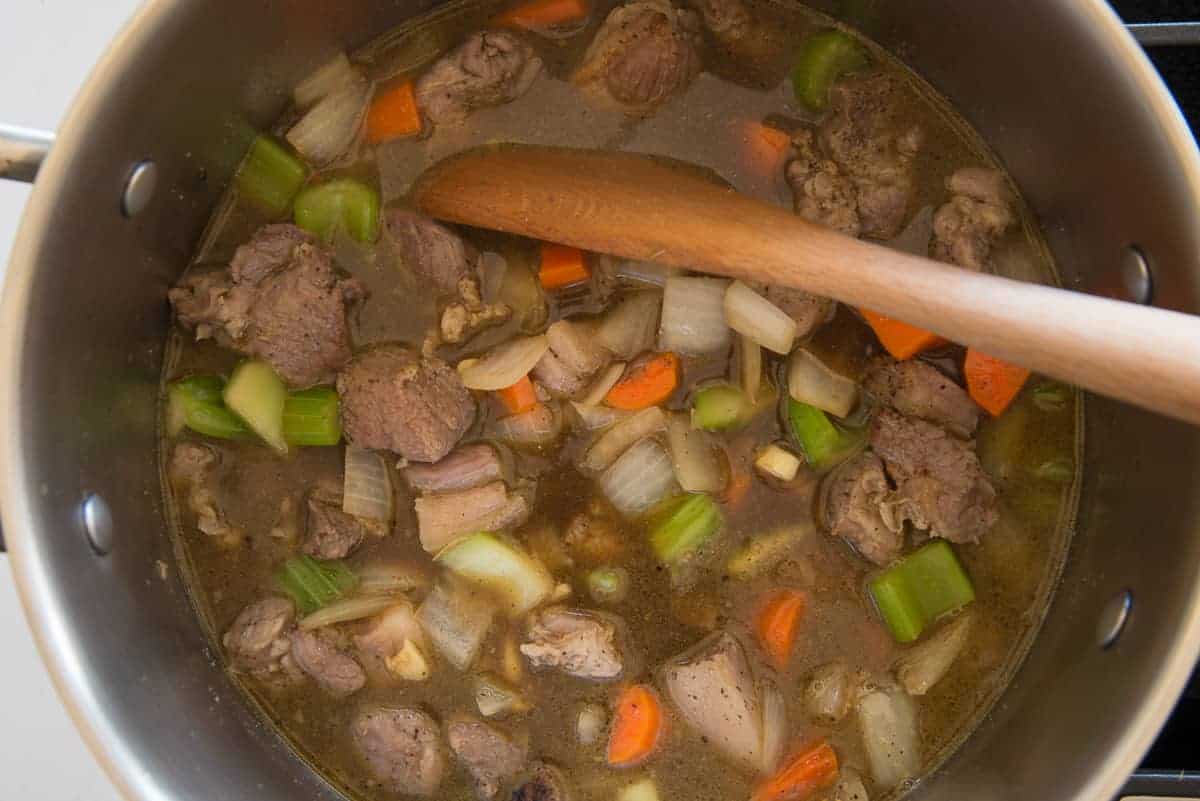
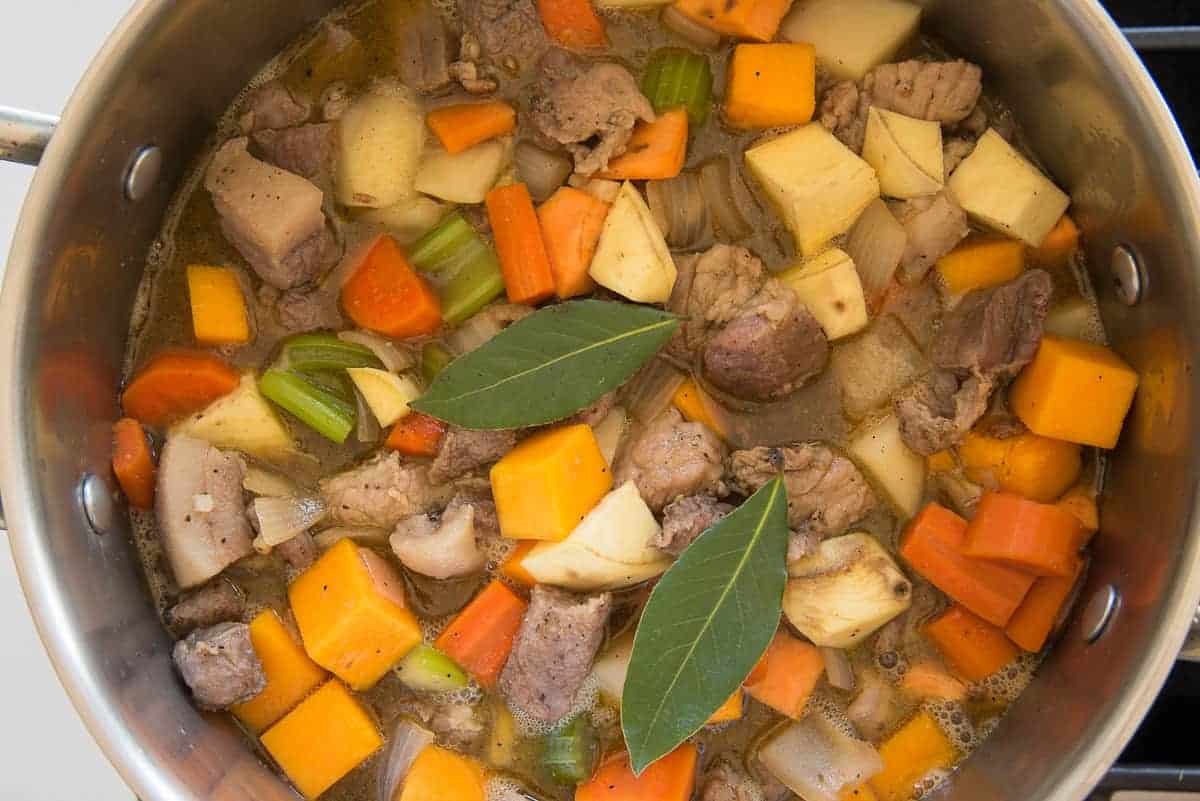
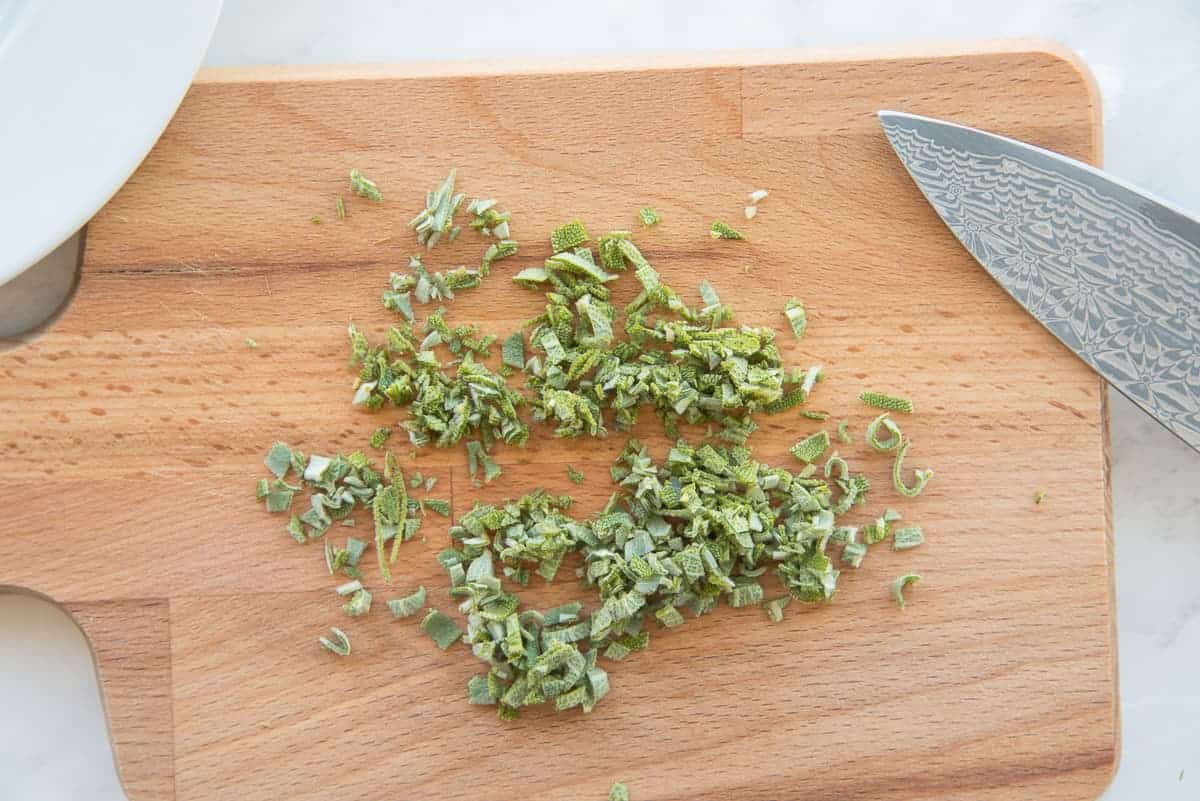
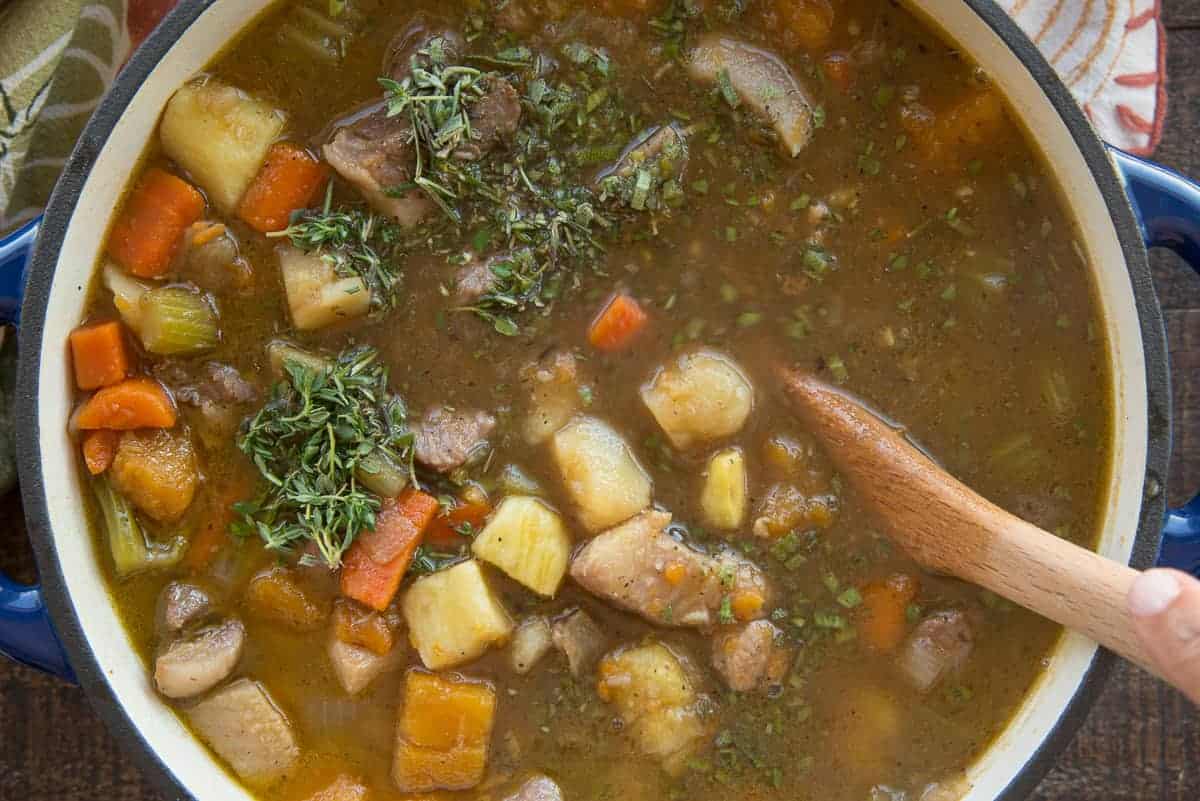
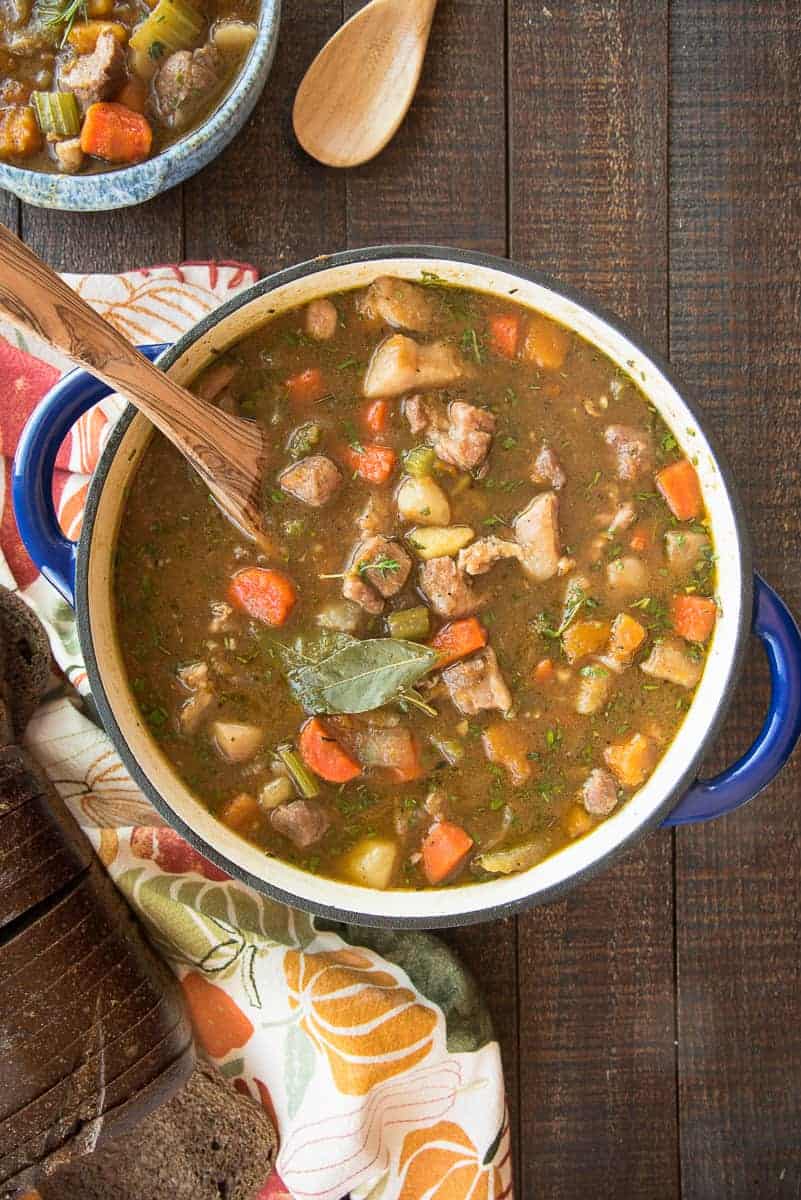
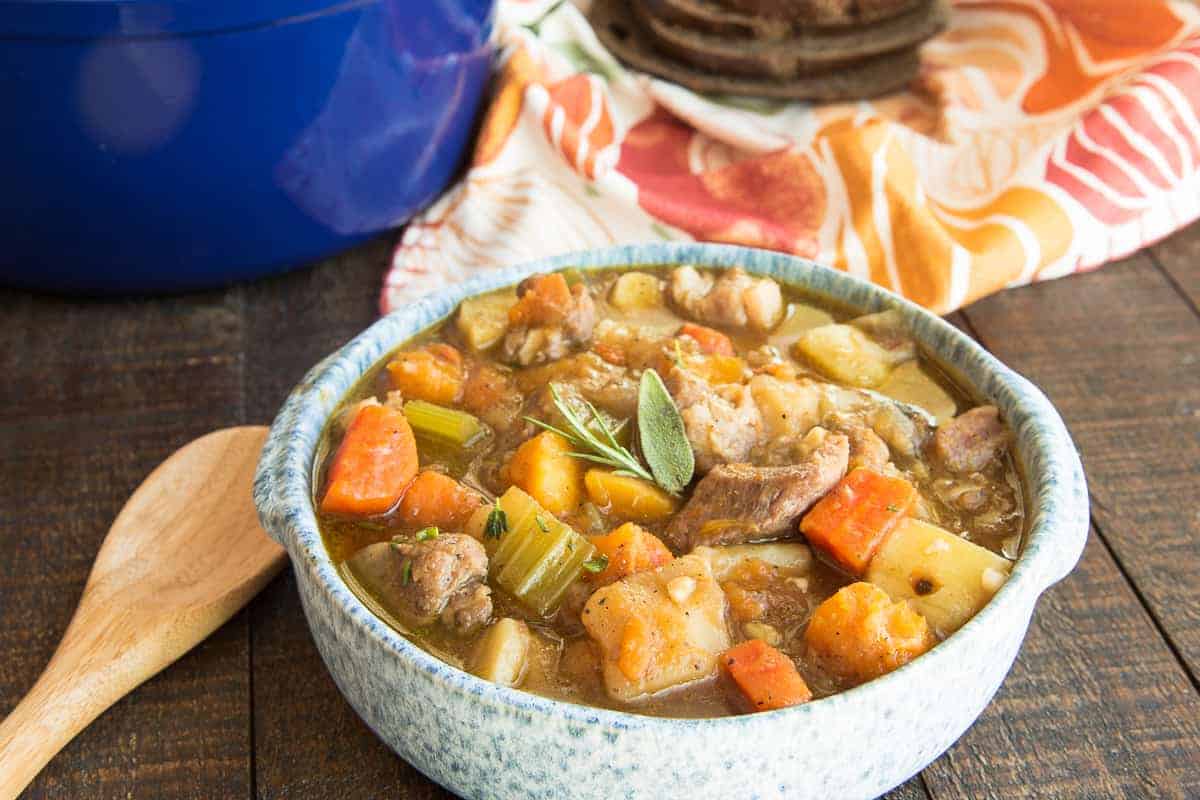
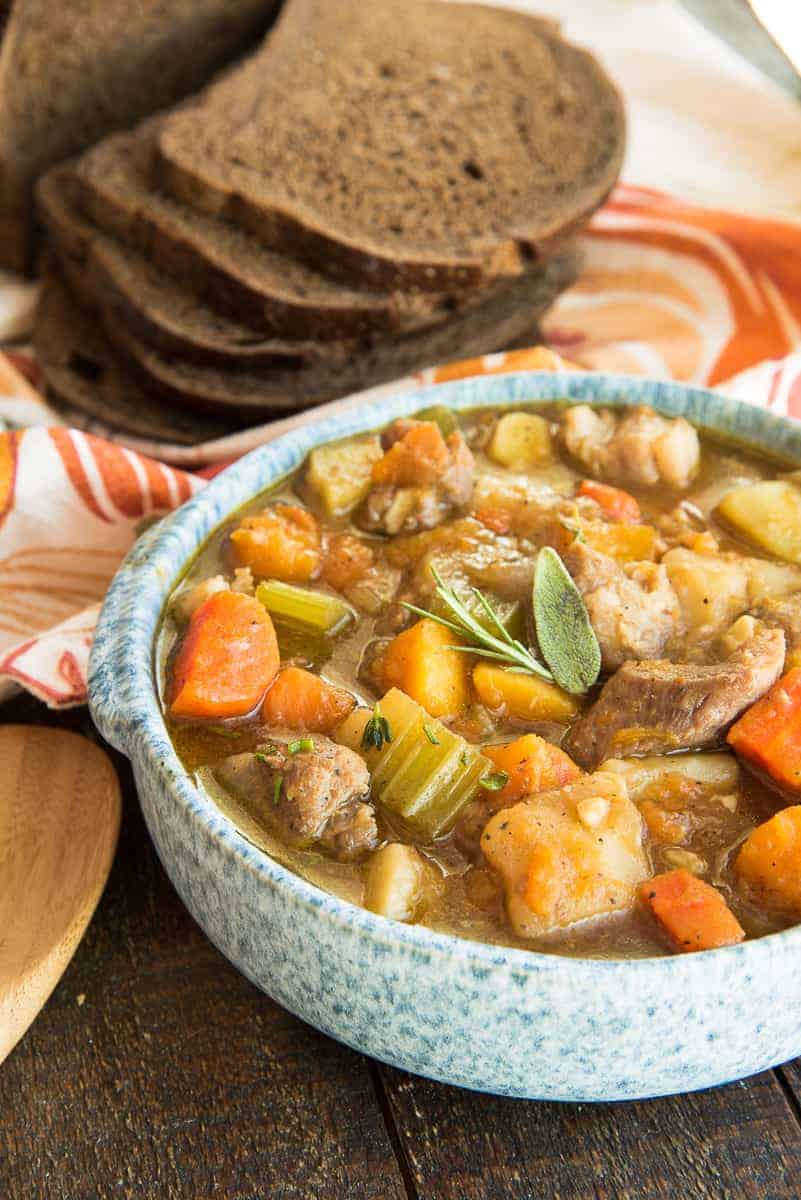

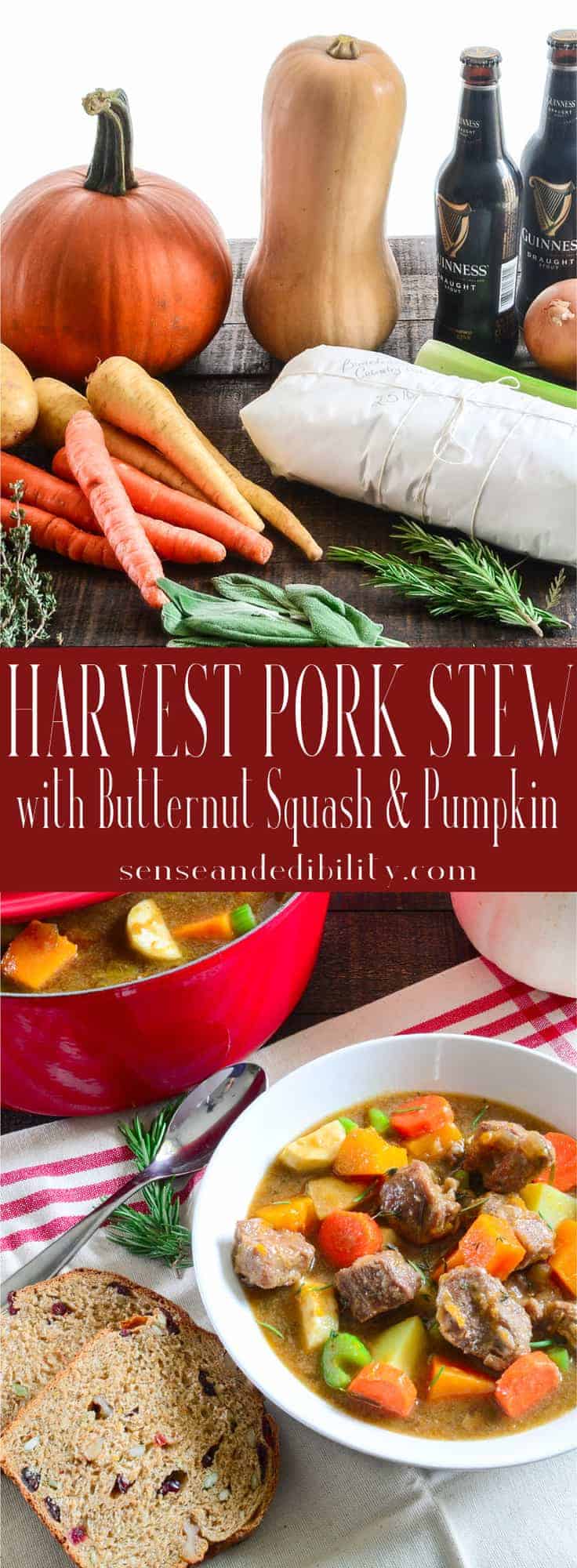





So good and nutritious!
Thanks, Lisa! I’m glad you liked it!
Is the white sweet potato the same as the one they serve in South Korea on the street – it’s kinda whitish on the inside (especially compared to the orange sweet potatoes). (The outside is a kinda reddish/purplish color…)?
Also, one more question, but I saw you have slow cooker directions too… Which version tastes better? Does it matter there? I guess I’ll be using the non-alcoholic version and substituting for beef stock (just so there’s no issues when serving this to a church gluten-free crowd). In this case, I would use the normal amount of need stock plus whatever the Guinness amount was – but in more beef stock, is that right?
Thank you for the both informative and interesting post! I wish I could grow carrots (or anything) that easily by ‘throwing some dirt in the back’ and forgetting about it!!!
I’ll have to come.back and rate the recipe and add a photo!
Hi Sejana, yes, boniato is the white sweet potato with the purple skin. It’s also called batata.
If you’re replacing the Guinness, you just add a cup and a half more of beef stock.
I prefer the stovetop version of the stew because it’s less work and less dishes. Plus, if for some reason the stew is too thin, it’s easier to simmer it to thicken it up on the stove than in the slow cooker. Enjoy!
I love a good hearty stew during these colder months! This was pure comfort!
I’m so glad you liked it, Tisha!
Yum this was delicious, such a nice hearty meal for the fall!
So glad you liked it, Jen!
This sounds amazing!!! And my husband would love that it’s made with a stout!
Yes, the stout gives it an acidic, malty finish.